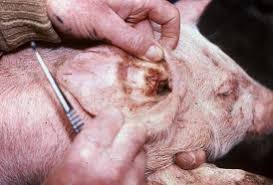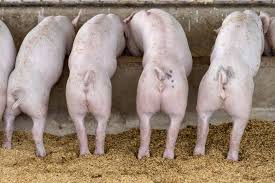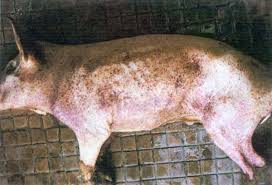Once disease affects a pig herd, the impact on the economics of pig production in terms of the cost of control and decreased productivity can be enormous. The first priority must therefore always be to try to prevent the occurrence of disease.
Many management procedures are aimed at disease prevention or mitigating the effects of those diseases that cannot be prevented. With skilled management, combined with well-designed housing and sound nutrition, an overall strategy to minimize the possibility of disease outbreaks can be formulated.
Local pig breeds are often more resistant to diseases. The most common problem with keeping pigs in free-range or semi-intensive systems is not disease but controlling infestation by worms or other parasites.
In intensive pig-keeping systems, disease is a greater risk because many animals are kept together in a small space, allowing infectious diseases to spread easily and quickly. Commercial breeds are often used in intensive systems, and these tend to be less resistant to disease.
Intensive pig production is a financial undertaking. Diseases can lead to production shortfalls, such as slower growth rates or loss of animals, resulting in income loss for the farmer.
In these circumstances, it is essential to take all necessary measures to prevent diseases and treat affected animals, provided the costs of treatment do not exceed the expected loss of income.
In free-range and some semi-intensive systems, farmers may not always have the financial resources for medical treatment, and pigs may not be their only source of income. In such cases, a drop in production may be considered less significant, and farmers may calculate whether the benefits of saving a sick animal and protecting others justify the cost of treatment.
If there is a high risk of an infectious disease outbreak, animals can be vaccinated to reduce losses. However, vaccines are not available for all diseases. For example, there is no vaccine against African Swine Fever (ASF).
This disease affects both local and commercial pig breeds. Free-range pigs contribute to the spread of ASF because they move around more than pigs kept in confined spaces.
Read Also: Hydroponics Garden Complete Beginners Guide
Parasitic Infections in Pigs

Parasites are organisms that live on and obtain food from a host. They may be external, living on the pig’s skin, or internal, residing in tissues and organs. Parasites rarely cause death unless infestations are severe or the pig is already stressed.
1. External Parasites
These mainly cause skin irritation, leading to wounds and increased susceptibility to infections. Common external parasites include mange mites, ticks, lice, fleas, and flies.
Control: Regular treatment through dipping or spraying with suitable acaricides or anti-mange medication, routine spraying of pigs and their quarters, and culling of chronic cases.
2. Internal Parasites
These include roundworms, tapeworms, and lungworms.
Control: Breaking the parasite life cycle by regularly moving range pigs to fresh ground, frequently removing feces in housed pigs, routinely dosing breeding pigs with broad-spectrum anthelmintics, deworming young stock after weaning, and preventing pigs from accessing human feces to control tapeworms.
Common Infectious Diseases in Pig Farming
1. African Swine Fever (ASF): A viral infection with no vaccine or treatment. Prevent direct contact between domestic and wild pigs. Strictly control pig movements and avoid feeding uncooked garbage from hotels. In case of an outbreak, bury or burn carcasses and disinfect housing. Rest the house for three months before reintroducing pigs.
2. Foot and Mouth Disease: A highly contagious viral disease with no cure. Vaccination can protect pigs if an outbreak occurs nearby.
3. Swine Erysipelas: A bacterial disease from soil exposure. Treatment with antibiotics is effective if administered timely. Vaccination is highly recommended.
4. Anthrax: A fatal bacterial disease that can infect humans. An effective vaccine is available. Suspected carcasses should not be opened to prevent the release of spores. Infected carcasses should be deeply buried.
5. Enteritis (Inflammation of the Intestine): Caused by microorganisms or inappropriate feed, leading to symptoms such as lethargy, fever, appetite loss, and diarrhea. If food-related, provide only clean water for one or two days, then gradually reintroduce feed.
6. Clostridium Enterotoxaemia: Affects piglets aged one to five days. No effective treatment, but vaccinating sows ensures piglets receive antibodies through milk. Piglets can also receive ampicillin or amoxicillin injections.
7. Tetanus: Occurs when bacteria enter deep wounds from rusty metal. Causes severe cramps, leading to death. No treatment is available.
8. Mastitis: Affects the udder, potentially causing permanent damage. Good hygiene reduces risk. Treatment involves antibiotics and oxytocin injections.
9. Brucellosis: Causes abortion in females and reproductive infections in males, potentially leading to sterility. Treatment is possible for females, but infected animals should be culled. Boars can transmit the disease without showing symptoms.
10. Trypanosomiasis: Transmitted by tsetse flies, causing fever, appetite loss, and rapid breathing. Eradicating tsetse flies is the only prevention. Long-acting drugs can offer protection.
11. Pneumonia: Caused by bacteria, viruses, or parasites, worsened by overcrowding, poor ventilation, low temperatures, and dust. Symptoms include coughing and labored breathing. Treatment involves antibiotics for bacterial infections and anthelmintics for lungworms.
12. Weil’s Disease (Leptospirosis): Characterized by sudden abortions in sows. During an outbreak, pregnant sows can be treated with dihydrostreptomycin injections to prevent further abortions.
Read Also: The Health Benefits of Using Dukkah Seasoning on your Cooking
Feed-related Diseases in Pigs

1. Anaemia (Iron Deficiency):
Affects young piglets raised indoors, causing pale skin and slow growth due to iron deficiency in the mother’s milk. Prevention includes providing iron-rich soil for rooting, iron dextran injections for newborn piglets, and supplementing minerals such as calcium and phosphorus with wood ash.
2. Constipation: Constipated sows should receive 60 g of linseed oil daily. If ineffective, administer 60 g of Epsom salts and encourage exercise.
Other Health Issues In Pigs
1. Sunstroke: Caused by excessive sun exposure, leading to skin burns and discomfort, particularly in white-skinned pigs. Prevention involves providing adequate shade. Treatment includes cooling the pig’s head with water and administering a small amount of brandy or whisky.
2. Wounds or Injuries: Can result from sharp housing materials or fights in overcrowded conditions. Prevention includes improving housing, avoiding overcrowding, and separating different age groups. Treatment involves antibiotic injections, wound cleaning, and the use of ointments.
3. Arthritis (Swollen Joints): Caused by bacterial infections, leading to swollen, painful joints and fever. Prevention includes disinfecting umbilical cords and providing smooth floors. Treatment involves antibiotic injections for five days.
The impact of diseases in pig farming, in terms of control costs and productivity losses, can be substantial. The primary focus should always be on disease prevention, supported by good management, proper nutrition, and effective housing systems.
Do you have any questions, suggestions, or contributions? If so, please feel free to use the comment box below to share your thoughts. We also encourage you to kindly share this information with others who might benefit from it. Since we can’t reach everyone at once, we truly appreciate your help in spreading the word. Thank you so much for your support and for sharing!
Frequently Asked Questions
We will update this section soon.

